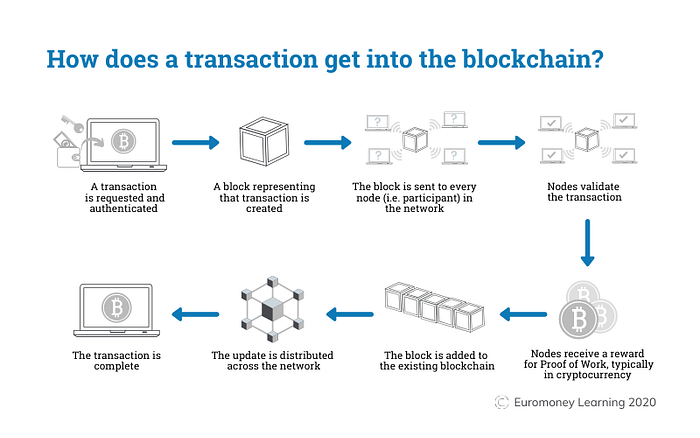Blockchains have a secure mechanism that is utilized to attain agreement on every block state of the blockchain ecosystem…
The fundamentals of blockchain technology
Consensus Mechanism
Blockchains have a secure mechanism that is utilized to attain agreement on every block state of the blockchain ecosystem. The entire process of the consensus mechanism includes validating and authenticating every transaction that takes place on the network.
In simple words, consensus makes sure that the data on-chain getting saved is valid and not tampered with. There are various consensus mechanisms like the Proof-of-Work (PoW), Proof-of-Stake (PoS), Proof-of-History (PoH), leader-based consensus, economy-based consensus, Proof-of-Authority (PoA), Virtual Voting consensus and Proof of Attendance (POAP) to check on the accuracy of data and the malicious behavior of any validator or miner on-chain.

The two well known mechanisms are PoW and PoS:
- Proof of Work
POW requires miners to solve complex mathematical problem to validate and confirm transactions over the network using consensus mechanisms to produce a new block to the chain.
The first Miner that has solves the cryptographic challenge then broadcasts the newly generated block using the Gossip protocol. Once a block of transactions has been verified, then it is added to the blockchain network.
A reward is given to the first miner who solves each cryptographic problem. - Proof of Stake
In a distributed consensus-based on the Proof of Work (POW), miners need a lot of energy to come up with the hash for the block that is less than or equal to the target for the blockchain network. In contrast, the Proof of Stake creator of the next block is chosen deterministically based on the stake in the blockchain.
POS is a low-energy consuming alternative to POW algorithm. POS has validators who own the stakes and the responsibility of maintaining the public ledger instead of Miners in POW. Polygon and Tezos are considered energy-efficient and environmentally friendly blockchains.
Types of Blockchain
Blockchain has a high level of security and transparency, as it provides the details of the transaction to all parties involved in the transaction. Every participant of the blockchain platform will have easy access to the details of the transactions processed on the blockchain network.
With businesses and start-ups increasingly integrating blockchain into their organization’s systems, the decentralized technology has been categorized into four main types based on its use cases:
- Public blockchain: it is non-restrictive, transparent, permissionless, fully distributed ledgers. No one individual or entity controls the blockchain and the transactions that are recorded in the blockchain. Anyone can view the transactions on the public blockchain.
- Private blockchain: it is centralized, restrictive, and users require permission to join. It is controlled by enterprises for recording their sensitive business data not to be visible outside the organization. Transactions are private and are only available to authorized users in the closed network.
- Hybrid blockchain is a combination of the private and public blockchain. It combines the permissioned feature of the private blockchain with the security and transparency feature of a public blockchain. Access-driven control decides which users can view the data on the blockchain or add data to the blockchain.
- Consortium blockchains are also known as federated blockchains. They allow any new participant on the block to connect the established structure and share data instead of beginning from the very start. Industries like logistics, healthcare & insurance, banking & finance implement the consortium blockchain.
The original blockchain was designed to operate without a central authority (i.e. with no bank or regulator controlling who transacts), but transactions still have to be authenticated.
Weakness of blockchain
- High Energy consumption to solve the cryptographic challenge in order to add a block to the blockchain
- Susceptible to 51% attack: this is an attack on the blockchain orchestrated when a group of miners on the blockchain network control more than 50% of the network’s hash rate or computing power to prevent new transactions from gaining confirmations, or ability to invalidate transactions that introduce double spend.

What companies are using private blockchains today and why?
If the internet has revolutionized the commercial sector in recent years through the development of marketplaces, the blockchain stands to change the real estate sector in terms of fluidity and distribution of information and transactions.
The overall lack of maturity of the technology makes businesses feel hesitant about using it. Blockchain is only a bit more than a decade old. Blockchain is expected to need more time to mature in order for it to become an attractive technology for businesses. The true benefits of DLT can only be taken advantage of when a critical mass of participants is reached. This requires a wide range of stakeholders across the supply chain to be committed to adopting the technology.
The number of potential applications of Distributed Ledger Technology (DLT) is vast. It can be used in sectors, such as trade finance, certifications, customs, freight and logistics, insurance, distribution and government procurement. Blockchain technology can help improve the efficiency of a number of processes and cut costs in several areas.
Bank & Insurance
And several banks and insurance companies, such as JP Morgan and MetLife, are using their own private blockchains to simplify, streamline and verify transactions and contracts that would previously have taken far longer and potentially been less secure.
Government
Transparency is a recurring issue for all industries. Blockchain is good for property for three main reasons: it creates a decentralised system (and therefore an inherently more trustworthy system), it improves the liquidity of property as an asset class, and finally, it helps remove the need for intermediaries.
Here is what Adam Redolfi, Managing Partner, says: “If the internet has revolutionized the commercial sector in recent years through the development of marketplaces, the blockchain stands to change the real estate sector in terms of fluidity and distribution of information and transactions. As the blockchain could shake up entire sectors of our global economy, all real estate professions are now concerned with the blockchain, from recording and funding to transactions, from real estate investment to appraisals to asset management.
Transparency is at the core of every transaction. While we try, as much as possible, to incorporate it in everything we do, eventually the current, obscured way of buying and selling homes will be a thing of the past. Blockchain is, of course, not the answer to all the problems in the real estate business.
However, with the blockchain, we now have a system that increases trust and reduces real estate broker dependency, while improving cost efficiency, accelerating transfers of homes and, most importantly, opening up avenues for networking by creating a digital platform other services can tie into.”
Real Estate
The all-in-one real estate transaction management software, Propy, leverages blockchain technology to streamline real estate transactions and mitigate the risk of fraud. Propy even offers properties that can be purchased using cryptocurrency.
Energy
Xage is the world’s first blockchain-enabled cybersecurity platform for IoT companies primarily in the transportation, energy and manufacturing industries. With the ability to self-diagnose and heal possible breaches, it leverages blockchain technology to manage billions of devices and protects industrial IoT operations against cyber attacks.
Healthcare
BurstIQ’s big data blockchain platform helps patients and doctors securely transfer sensitive medial information using smart contracts that establish the parameters of what data can be shared.
Creative industries
Comcast has partnered with other industry leaders to launch Blockgraph, a blockchain-based system which allows advertisers to target viewers with specific adverts while maintaining viewers’ privacy.
In April 2017, the streaming giant Spotify acquired blockchain startup Mediachain in an effort to create a fairer, more transparent, and rewarding music industry for musicians. Prior to its acquisition, Mediachain had developed several technologies that could aid in these efforts, including a decentralized, peer-to-peer database that connects applications to media and information about it, the Mediachain Attribution Engine, and a cryptocurrency that rewards artists for their work.
Logistics
Walmart has developed a blockchain system based on Hyperledger Fabric to trace the provenance of their products. The blockchain allows suppliers to upload certificates of authenticity to the ledger securely, bringing more trust to a system and enabling the company to trace products back to source within seconds rather than days.
After successful trials with two products, the company is looking to roll it out further. Like other private blockchains, Walmart’s traceability system does require its suppliers to participate in the system to ensure its veracity, but the company is large enough to impel them to comply.
De Beers has launched a ‘secure and immutable trail’ using a private blockchain called Tracr, to verify the authenticity and provenance of diamonds and ensure they are not “blood diamonds” from conflict zones.
Shipping giant DHL is at the forefront of blockchain-powered logistics. One of the largest shipping companies to embrace blockchain, it uses the technology to maintain a digital ledger of shipments and protect the integrity of transactions.








